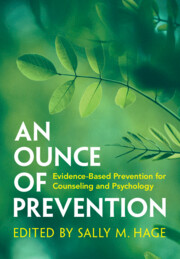Book contents
- An Ounce of Prevention
- An Ounce of Prevention
- Copyright page
- Dedication
- Contents
- Figures
- Contributors
- Acknowledgments
- Part One A Foundation in Prevention
- Part Two Prevention with Children and Youth
- 4 Culturally Relevant Prevention Interventions for African American Children and Families: Lessons Learned from “Real-World” Implementation of the Black Parenting Strengths and Strategies – Racialized Short (BPSS-RS) Program
- 5 The Right Supports to the Right Students at the Right Time over Time: How Schools and Communities Can Make It Happen
- 6 Systemic Interventions to Promote Well-Being in Black, Indigenous, and People of Color Students Attending K-12 Schools
- 7 Building Race-Centered, Trauma-Responsive Schools: One Path toward Justice in Education
- Part Three Prevention with Emerging Adults
- Part Four Across the Lifespan: Adults and Families
- Part Five Closing
- Index
- References
5 - The Right Supports to the Right Students at the Right Time over Time: How Schools and Communities Can Make It Happen
from Part Two - Prevention with Children and Youth
Published online by Cambridge University Press: 14 November 2024
- An Ounce of Prevention
- An Ounce of Prevention
- Copyright page
- Dedication
- Contents
- Figures
- Contributors
- Acknowledgments
- Part One A Foundation in Prevention
- Part Two Prevention with Children and Youth
- 4 Culturally Relevant Prevention Interventions for African American Children and Families: Lessons Learned from “Real-World” Implementation of the Black Parenting Strengths and Strategies – Racialized Short (BPSS-RS) Program
- 5 The Right Supports to the Right Students at the Right Time over Time: How Schools and Communities Can Make It Happen
- 6 Systemic Interventions to Promote Well-Being in Black, Indigenous, and People of Color Students Attending K-12 Schools
- 7 Building Race-Centered, Trauma-Responsive Schools: One Path toward Justice in Education
- Part Three Prevention with Emerging Adults
- Part Four Across the Lifespan: Adults and Families
- Part Five Closing
- Index
- References
Summary
This chapter begins by distinguishing among prevention, intervention, and promotion efforts, giving particular attention to how these processes operate in the context of schools. One example of a school-based, evidence-based practice – City Connects – is used to illustrate how prevention, promotion, and intervention can be operationalized in the contexts of schools and their local communities. As a clinical/public health model, City Connects is responsive to every child in the school, without an exclusive focus on either the subset of students who are in severe crisis or those who are highest performing. The authors argue that prevention-in-action requires working across polarities, such as intervening at both the individual and group levels, targeting challenges while fostering strengths and interests, and promoting healthy development while simultaneously intervening in existing difficulties. The chapter concludes with a summary of challenges and possibilities in implementing high-quality prevention and promotion approaches, such as developing a theory of change based on developmental science that includes measurable outcomes.
Keywords
- Type
- Chapter
- Information
- An Ounce of PreventionEvidence-Based Prevention for Counseling and Psychology, pp. 85 - 106Publisher: Cambridge University PressPrint publication year: 2024

